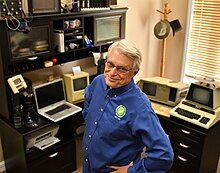Robert C. Martin | |
|---|---|
 Martin in 2020 | |
| Born | Robert Cecil Martin 5 December 1952[1] |
| Nationality | American |
| Other names | "Uncle Bob" Martin |
| Occupation(s) | Software engineer[citation needed], instructor |
| Known for | Agile Manifesto, SOLID principles |
| Children | 4 |
| Website | cleancoder |
Robert Cecil Martin (born 5 December 1952), colloquially called "Uncle Bob",[2] is an American software engineer[citation needed], instructor, and author. He is most recognized for promoting many software design principles and for being an author and signatory of the influential Agile Manifesto.[3]
Martin has authored many books and magazine articles. He was the editor-in-chief of C++ Report magazine and served as the first chairman of the Agile Alliance.[4][5]
Martin joined the software industry at age 17 and is self-taught.[6]
Professional work[edit]
In 1991, Martin founded Object Mentor,[7] now defunct, which provided instructor-led training on the extreme programming methodology.[8] As of November 2023[update], he operated Uncle Bob Consulting, which provides consulting and training services.[9] He serves as Master Craftsman / Mentor at Clean Coders, a company run by his son Micah Martin, and produces training videos.[10]
Software principles advocacy[edit]
Martin is a proponent of software craftsmanship, agile software development, and test-driven development.[11]
He is credited with introducing the collection of object-oriented programming (OOP) design principles that came to be known as SOLID.[12]
Publications[edit]
- 1995. Designing Object-Oriented C++ Applications Using the Booch Method. Prentice Hall. ISBN 978-0132038379.
- 2000. More C++ Gems. Cambridge University Press. ISBN 978-0521786188.
- 2002. Agile Software Development, Principles, Patterns, and Practices. Pearson. ISBN 978-0135974445.
- 2003. UML for Java Programmers. Prentice Hall. ISBN 978-0131428485.
- 2006. Agile Principles, Patterns, And Practices in C#. Pearson. ISBN 978-0131857254.
- 2009. Clean Code: A Handbook of Agile Software Craftsmanship. Prentice Hall. ISBN 978-0132350884.
- 2011. The Clean Coder: A Code Of Conduct For Professional Programmers. Prentice Hall. ISBN 978-0137081073.
- 2017. Clean Architecture: A Craftsman's Guide to Software Structure and Design. Prentice Hall. ISBN 978-0134494166.
- 2019. Clean Agile: Back to Basics. Prentice Hall. ISBN 978-0135781869.
- 2021. Clean Craftsmanship: Disciplines, Standards, and Ethics. Addison-Wesley Professional. ISBN 978-0136915805
- 2023. Functional Design: Principles, Patterns, and Practices. Addison-Wesley ISBN 978-0138176396
References[edit]
- ^ Groupon OnAir (July 26, 2016). The Future of Programming with Uncle Bob Martin. YouTube.
- ^ Heusser, Matthew (May 10, 2011). "Do Professional Programmers Need a Code of Conduct? An Interview with Robert C. "Uncle Bob" Martin". InformIT. Retrieved February 26, 2015.
- ^ "Authors: The Agile Manifesto". Manifesto for Agile Software Development. 2001. Retrieved January 16, 2020.
- ^ "Robert C. Martin". IEEE Xplore. Retrieved August 1, 2021.
- ^ Sondra Ashmore; Kristin Runyan (2014). Introduction to Agile Methods. Addison-Wesley Professional. p. 10. ISBN 9780133435214.
- ^ Martin, Robert C. (December 10, 2018). "Uncle Bob on X". X (formerly Twitter). Retrieved November 23, 2023.
- ^ "Robert Martin (Uncle Bob) - Scrum Alliance". www.scrumalliance.org. Retrieved November 30, 2022.
- ^ "Object Mentor: About | LinkedIn". LinkedIn. Retrieved November 23, 2023.
- ^ "Robert Martin | LinkedIn". LinkedIn. Retrieved November 23, 2023.
- ^ "Clean Coders : Level up your code". cleancoders.com. Retrieved November 23, 2023.
- ^ "UBC". cleancoder.com. Retrieved November 23, 2023.
- ^ Martin, Robert C. (2000) "Design Principles and Design Patterns"(PDF). objectmentor.com. Archived from the original on 2015-09-06
Well, that’s interesting to know that Psilotum nudum are known as whisk ferns. Psilotum nudum is the commoner species of the two. While the P. flaccidum is a rare species and is found in the tropical islands. Both the species are usually epiphytic in habit and grow upon tree ferns. These species may also be terrestrial and grow in humus or in the crevices of the rocks.
View the detailed Guide of Psilotum nudum: Detailed Study Of Psilotum Nudum (Whisk Fern), Classification, Anatomy, Reproduction